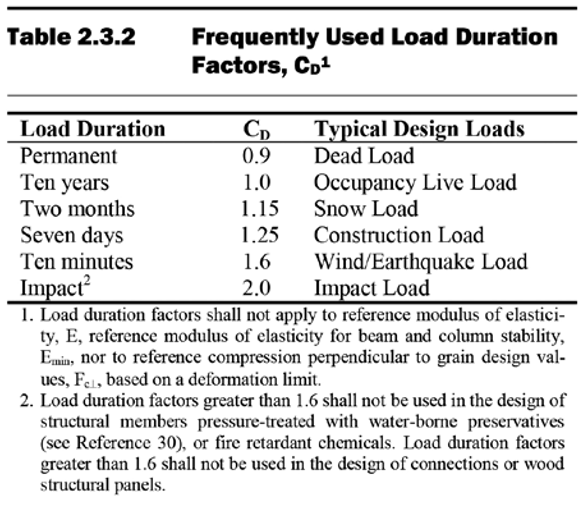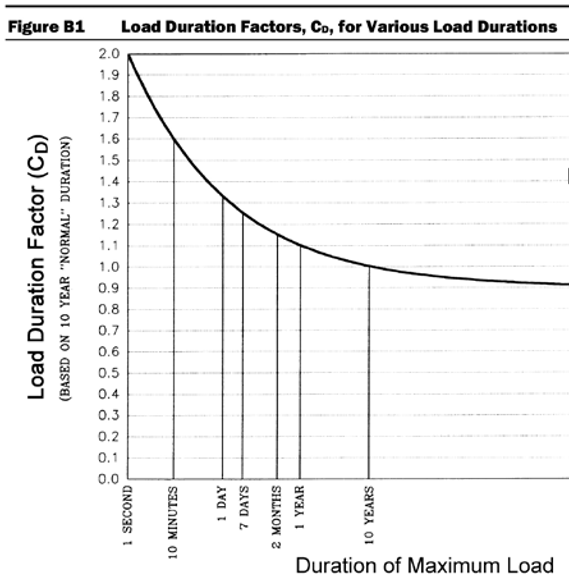Load Duration Is a Wood Design Tradition
Load Duration Is a Wood Design Tradition
Lumber has a unique structural characteristic: its ability to handle higher stresses under shorter periods of time. This characteristic is accounted for during design through what is known as a Load Duration Factor (LDF). It is typically applied behind the scenes without a truss designer needing to know anything about it because it is tied to truss loading conditions, and industry software automatically uses the LDF factors to undertake truss design. Given that this is a property unique to wood, it is worthwhile for truss and building designers, in a heavily wood-based industry, to fully understand what this factor is and how it can affect their designs.
Think about the loads that you typically see in a building. The weight of the materials that make up the building or actual dead loads are present in the building from the day the building is constructed until it is taken down. Actual dead load and design dead load can be (and often are) different, with design dead load being greater than actual dead load. Building designs can always be performed using actual dead loads when those are well known.
Live loads affect the building less but a portion are still applied through the useful life of the building. Roof live load rarely occurs and when it does, it’s for a very short amount of time. The typical roof live load (not snow, which is also considered a live load) is walking on the roof during repairs, watching July 4th fireworks from the roof, and every now and then having a tree fall on your roof. Each of these events are rightly considered short-term loading conditions.
All of this relates to the idea of load duration, which is the accumulated amount of time during the life of the building that loads will be applied. All of these loads are relative to “normal” loading, which is defined as a “10-year load duration.”
For reference, live loads are considered normal loads. Table 2.3.2 from the 2018 NDS shows the load duration factors for different durations of loads (this table can also be found in Table 6.4-1 in TPI 1-2014). The LDF concept is based on the engineering mechanics concept of elasticity. Elasticity means that when a load is applied to wood it deforms, and when the load is taken off the wood it springs back to its original position. Long ago, testing was done at Forest Products Laboratory to give wood a special feature called LDF to account for two things: 1) wood is very elastic; and 2) the more load that is applied to wood, the more creep deformation occurs over time.
A good example is bending a yardstick. It can be bent frequently and come back to its original position. However, if you put a weight on a yard stick between two chairs that causes it to bend six inches and leave it in that position for six months, what will the yard stick look like? This is, to simplify the fundamental concept, the effect that LDF is trying to capture when designing for wood.
SBCA’s Load Guide has additional useful information regarding loading concepts including LDF.
LDF is a part of Allowable Stress Design (ASD), which is the analysis method used in wood design since the 1940s, and made its way into the National Design Specification for Wood Construction (i.e., NDS 1948) and then into TPI-62 for truss design and has been with us ever since.
The other analysis method, Load and Resistance Factor Design (LRFD), uses a similar approach to account for time. This factor is referred to as the Time Effect Factor. The Load Duration Factor Curve, aka the Madison Curve, is shown below.
The Madison Curve shown is taken from Appendix B of the NDS where more information on LDF can be found.
The factor is applied like other loading factors, in that the design value specified in the NDS is multiplied by the load duration factor to determine the allowable stress. This factor is applicable to bending, tension, shear, and compression parallel to grain reference design values that are found in Supplement 4 of the NDS.
What happens if there are multiple load durations within a load case, for example, D+L? Dead load has a load duration factor of 0.9, while normal duration live load (e.g., furniture, beds, people in a room, etc.) has an LDF factor of 1.0. The NDS provides the following counsel for applying the load duration factor:

While this is not a factor that truss or building designers will need to use in hand calculations, it is worth knowing. Maybe a building official will ask why you used a load duration factor of 1.15 instead of 1.25 or 1.6 instead of 2.0. A designer who understands this concept will be better equipped to explain the reasoning behind it and allow everyone to make informed design choices in the future.




